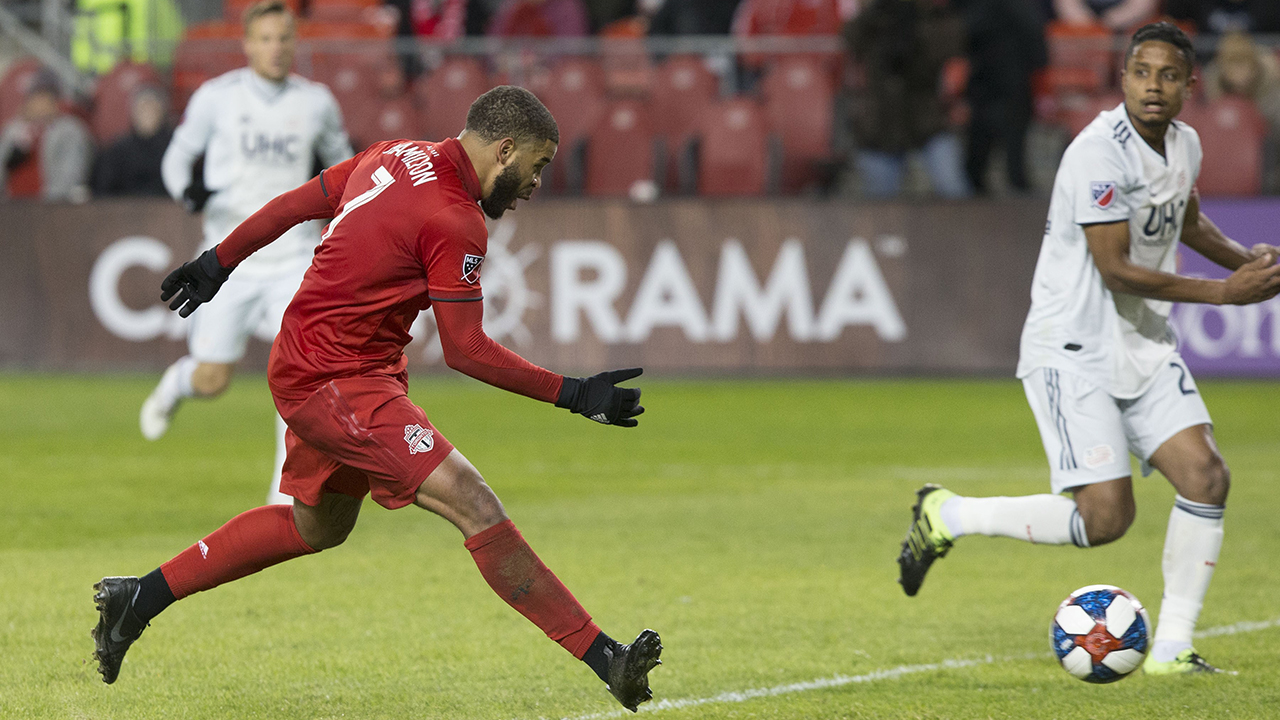You might think you know soccer’s offside law, but chances are very good that you don’t fully understand it.
Have a read here and let me know if it’s all entirely clear to you.
Confused? You’re not the only one. It’s not as straight-forward as you thought, right? It’s not black and white. Instead, there are shades of grey in the minor details and caveats that reveal mind-numbing absurdities.
The patent ridiculousness of one aspect of the offside law was on full display during Sunday night’s Toronto FC-New England Revolution match when Jordan Hamilton’s goal was allowed to stand in the Reds’ eventual 3-2 win.
Just before halftime, Toronto forward Ayo Akinola fed a ball to teammate Jay Chapman, who was in an offside position. Akinola’s pass took a slight deflection off New England defender Antonio Mlinar Delamea, who tried to intercept it. The ball found its way to Chapman, and he scampered down the left flank before sending a pass across the box for Hamilton to tap in and give TFC a 2-1 lead going into the break.
The assistant referee on the far side of the pitch raised his flag, presumably to signal offside, after Chapman received the ball, but then quickly put it down as the play continued. After Hamilton scored, VAR reviewed it and eventually referee Ted Unkel let the goal stand.
Chapman was clearly in an offside position when Akinola played the pass towards him, and under normal circumstances the goal would have been disallowed. But a section of the offside rule, otherwise known as Law 11, dictates that “a player in an offside position receiving the ball from an opponent who deliberately plays the ball … is not considered to have gained an advantage.”
In this case, what this means is that although Chapman was in an offside position when Akinola played him down the left wing, he was played back onside because defender Delamea made a deliberate play on the ball.
Make sense to you? It didn’t to New England coach Brad Friedel, either.
“The thing is, [Chapman] was in an offside position when the ball was passed to him and that is why [Delamea] had to lunge for the ball; that’s the play,” Friedel told reporters after the game.
Chapman clearly gained an advantage from being in an offside position, so why does it matter that Delamea made an attempt on the ball?
Chapman was only two to three yards offside. But, as Friedel pointed out, the ludicrousness of the decision could have been further exposed had the TFC midfielder been further up the field at the time Akinola played the ball to him.
“Let’s say [Chapman] was 15 yards offside and it deflected off the defender. Are they going to allow the goal? That’s a player standing in an offside position gaining an advantage, so I don’t think that that should be allowed,” Friedel offered.
He later added: “I understand if it’s not played to [Chapman], perhaps, and it deflects over in his way. But the actual ball was played to him and he’s standing two-to-three yards offside. I don’t care if it deflects off anyone, I don’t understand how he’s not deemed offside.”
What’s even more absurd is that had Delamea not made an attempt to intercept the ball or make a clearance, Chapman would have been ruled offside because he would have been considered to have gained an advantage.
It’s difficult to understand the logic behind punishing Delamea for making an attempt on the ball. It’s also beyond unreasonable to expect a defender in that instance to go against his natural instinct and let the ball run through, to say nothing of the fact he has to make that decision within a bat of an eye.
“I’m not going to say I agree with it, because as a former defender, it’s incredibly challenging to have to make a split-second decision and be able to also calculate for the guy that’s offside. It’s a really difficult rule,” Toronto coach Greg Vanney said.
TFC captain Michael Bradley explained that “the referee made the right call” in terms of the way the offside rule is interpreted. But like Friedel, he didn’t think Hamilton’s goal should have stood.
“I don’t think anybody likes the way the law is interpreted right now. For me, that should be offside,” Bradley admitted after the game.
“For a lot of people, a lot of players, a lot of coaches, it’s a strange way to interpret the rule.”
I’m all for letting goals stand when an attacking player is in offside positon but he is deemed to not be active or interfering in the play. Goals are the lifeblood of the game, and scoring must and should be encouraged.
But common sense has to prevail here. The inescapable fact is that Chapman received an undeniable advantage from being in an offside position. Delamea’s attempt to play the ball shouldn’t negate that.
Simplicity and clarity should be the order of the day when it games to the game’s laws. Hamilton’s goal being allowed to stand runs contrary to that principle.
[relatedlinks]










